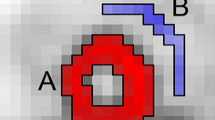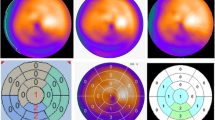Abstract
The upward creep of the heart during myocardial single photon emission tomography (SPET) acquisition has been reported as a frequent source of false-positive results. The aim of this study was to simplify the detection and correction of this upward creep and to estimate its clinical relevance during routine patient care. To recognize the upward heart motion a straight line was fitted to the upper and lower border of consecutively displayed tomographic projection images. In this way, vertical translation of at least 1 pixel in size could be detected easily. On the assumption of a slow but continuous upward motion a fast interpolation correction method was developed. From 100 consecutive, supine, ergometric exercise studies, 1, 2 or 3 pixels of upward creep were found in 16, 4 or 3 patients, respectively. It was found that an upward creep of at least 2 pixels (7/100 cases) led to evident, mostly antero-septal defects on quantitative bull's-eyes, whereas only upward creeps of 3 pixels or more (3/100 cases) produced false-positive diagnostic results. The simple correction method offered a sufficient compensation of image and/or bull's-eye artefacts. These clinical findings could be reproduced in a computer model. Thus, it can be stated that clinically significant upward creep of the heart during stress SPET acquisition is relatively rare; it may have been overestimated in the past, and its artificial effects can be corrected by a quick and simple algorithm.
Similar content being viewed by others
References
Clausen M, Küstermeier W, Mack S, Henze E, Weller R, Langhans J, Ost W, Schmidt A, Adam WE (1989) Integrated head-arm-support for myocardial SPECT — a technique to avoid movement artefacts. Nucl Comp 20:209–212
DePuey EG, Garcia EV (1989) Optimal specificity of thallium-201 SPECT through recognition of imaging artefacts. J Nucl Med 30:441–449
Eisner R, Noever T, Nowak D, Carlson W, Dunn D, Oates J, Cloninger K, Liberman HA, Patterson RE (1987) Use of cross-correlation function to detect patient motion during SPECT imaging. J Nucl Med 28:97–101
Eisner R, Churchwell A, Noever T, Nowak D, Cloninger K, Dunn D, Carlson W, Oates J, Jones J, Morris D, Liberman H, Patterson R (1988) Quantitative analysis of the tomographic thallium-201 myocardial bull's-eye display: critical role of correcting for patient motion. J Nucl Med 29:91–97
Friedman J, Garcia E, Berman D, Bietendorf J, Prigent F, Van Train K, Waxmann A, Maddahi J (1984) Motion detection andcorrection in Tl-201 SPECT imaging: a simple, practical method [abstract]. J Nucl Med 25:P70
Friedman J, Van Train K, Maddahi J, Hasegawa B, Bietendorf J, Waxman A, Berman D (1986) “Upward creep” of the heart: a frequent source of false-positive reversible defects on Tl-201 stress-redistribution SPECT [abstract]. J Nucl Med 27:899
Friedman J, Van Train K, Maddahi J, Rozanski A, Prigent F, Bietendorf J, Waxman A, Berman DS (1989) “Upward creep” of the heart: a frequent source of false-positive reversible defects during thallium-201 stress-redistribution SPECT. J Nucl Med 30:1718–1722
Garcia EV, Van Train K, Maddahi J, Prigent F, Friedman J, Areeda J, Waxman A, Berman DS (1985) Quantification of rotational thallium-201 myocardial tomography. J Nucl Med 26:17–26
Geckle WJ, Frank TR, Links JM, Becker LC (1988) Correction for patient and organ movement in SPECT: application to exercise thallium-201 cardiac imaging. J Nucl Med 29:441–450
Hecht HS, Shaw RE, Bruce T, Myler RK (1989) Silent ischemia: evaluation by exercise and redistribution tomographic thallium-201 myocardial imaging. JACC 14:895–900
Rothendler JA, Okada RD, Wilson RA, Brown KA, Boucher CA, Strauss HW, Pohost GM (1985) Effect of a delay in commencing imaging on the ability to detect transient thallium defects. J Nucl Med 26:880–883
Author information
Authors and Affiliations
Additional information
Research fellow of the Alexander von Humboldt Foundation working at Department of Nuclear Medicine, University Medical School Szeged, Hungary
Rights and permissions
About this article
Cite this article
Mester, J., Weller, R., Clausen, M. et al. Upward creep of the heart in exercise thallium 201 single photon emission tomography: clinical relevance and a simple correction method. Eur J Nucl Med 18, 184–190 (1991). https://doi.org/10.1007/BF02262729
Received:
Revised:
Issue Date:
DOI: https://doi.org/10.1007/BF02262729




